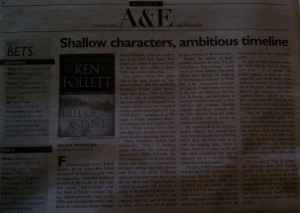Winning has been surprisingly good so far. It lacks a lot of depth, but that’s also kind of nice. After reading a lot of business books, I’m starting to learn to skim through them and pick up the relevant details. Most of these books tend to be fluff, to be honest. There are ideas that you can capture in 30 seconds which the authors feel they have to regurgitate over and over. I will say that Winning — at least so far — tends to be devoid of that same repetition.
I’m trying to focus on thinking more critically about books that I read these days. Instead of just absorbing them, I want to determine if I agree with the message that it is spreading. If I do, I should take the time and effort to internalize that message and use it to enact change in my life. Otherwise, you may as well just watch TV instead, right?
In order to do this, I’m going to do brief reviews of the chapters and/or sections as I read them. I don’t want to make them long — I’ve learned from the past that even I don’t want to read my longer blog entries. Instead, I want to focus on summarizing the key concepts, determining whether I agree with them, and then, if necessary, setting concrete goals for how to change. I have something like the scientific method rattling around in my head — question, hypothesis, prediction, test, analysis (I actually had to look those up on Wikipedia, how sad).
I’m going to shoot to keep these reviews and ideas to whatever I can write in 15 minutes and go from there. Let’s see how it goes (and give me feedback!). Start time: 6:12 PM.
Winning – Underneath It All
This section of the book is comprised of four chapters:
- Mission and Values
- Candor
- Differentiation
- Voice and Dignity
Mission and Values
Mission and Values is an interesting chapter that covers mission and value statements that companies make. I have to admit that I agree with Jack on this one: most of these statements are complete crap. I hated creating these in school because they seem too nebulous. However, he advocates making them as concrete as possible. They’re to be used as a guide for your specific company or enterprise — don’t just choose random stuff and buzzwords and plug it in there.
According to Jack, you (as a leader) have to constantly remind people to use the stated mission and values as yardsticks for your decisions. If something in your company changes, then you should analyze your statements and see if they make sense. If not, make new ones. Arthur Andersen and Enron are actually used as specific examples of companies that lost sight of their mission and value statements and paid the price for it. I think it’s interesting that Jack uses accounting/audit as examples throughout the book.
Although I groan at the thought, I think these topics can be applied to both my personal and professional paths. Mission and value statements are a good way to start focusing on your individual objectives. For me, maybe that’s Toastmasters, the Secret Society, the WellPoint engagement, or just my life in general. Having a mission statement for my life would be a quick way to make sure that I am being proactive instead of reactive (I believe most people are reactive in their lives).
Question: Will having concrete mission and value statements help clarify my objectives?
Hypothesis: Developing concrete mission and value statements will increase the focus of the development of my goals, make decisions easier, and help me be proactive instead of reactive.
… I’m going to have to work on how to develop these scientific method parts. It’s not as easy at it looks. I don’t want to just copy and paste the sections — that’s just like choosing values from a list of buzzwords. Gotta think about this more.
Candor
In Jack’s autobiography, Jack: Straight from the Gut, he makes it abundantly clear that he is blunt and abrasive. It almost cost him the promotion to GE’s CEO position. I’m sure it burned a ton of bridges for him along the way. However, he goes into great lengths to extol the virtues of being candid.
For the most part, I agree with him, and think this is something I need to work on. I’ve always been a people-pleaser that has been focused on making people happy. That’s great for some aspects: salesmanship comes to mind. I’ve always been able to pretty easily pick apart what will make people happy and do that.
However, if I had to really look at it, I’m not sure that is a great element of a leader. As I step into positions where I need to boss people around, give them feedback, and really coach people for whom I am responsible, I think being candid will be increasingly important. For me personally, I also need to figure out how to deal with people that are extremely candid. I tend to take things personally and have a hard time bouncing back from people’s criticisms of me. Again, that can be a good thing — I tend to put more effort into thinking about how to make people happy to avoid feeling like I disappointed them — but, again, is that a quality of a good leader? I feel like you need the best of both worlds. Charm them, make them happy, but also be able to be candid, open, and honest.
Question: Does being candid pay off in the short and long term?
Hypothesis: Being candid increases the overall value of relationships and productivity by eliminating the need for social gesturing.
Prediction: Being candid will be temporarily painful, but will pay off in the long term.
Experiment: When I find myself being too politically correct, instead just speak my mind. If necessary, give a disclaimer that I am going to be speaking my mind, but still speak my mind. Believe that others are strong enough to take candid feedback instead of assuming that they can’t.
Differentiation
Differentiation is basically Jack’s title for his 20-70-10 rule: 20% are top performers and get lavished with gifts, training, and put on the fast track to management; 70% are the core of the business and should be kept happy but are not superstars; 10% are underperformers, do not fit with the company’s mission and values, and should be mentored out of the organization.
When I first read about this “up or out” method a few years ago in Jack’s biography, it caught me off guard. It sounded so brutal. Every year, GE managers had to rank their employees and get rid of the bottom 10%. Even if you had a great team, you had to get rid of 10% of it. It didn’t really make sense to me at that point.
After a little bit more experience, I think I see where he is coming from and somewhat agree with his methods. It’s rather like “tough love,” but I’m starting to see that it’s really good for those people — even those that get counselled out. I still tend to put a very human face to everyone that might get let go, even though they’re good, just not good enough.
For example, theoretically you counsel someone out and they go on to bigger and better things. Maybe they find a different company, different career path, or some other change in their life that makes them happier. That’s how it’s supposed to work, right? But, especially in today’s recessionary economic conditions, wouldn’t it be extremely difficult for those opportunities to arise? Instead, people are worried about their jobs and getting food on the table. It’s hard to argue that getting let go was good for them in that case.
Regardless, I can see myself adopting this strategy as I gain more managerial roles. I’ve been pretty disappointed with the performance of people in general, so I can understand the need to have this up-or-out mentality. I’ll skip the scientific method on this section as I can’t see how to test this.
Voice and Dignity
Jack’s point here is that everyone deserves a voice and should be listened to. No, not every idea should be acted on, but every voice should be heard. It’s this type of environment that facilitates the creation of ideas. It drives people to ask the right questions and pursue the answers to those questions relentlessly.
I agree to this wholeheartedly. As creative as people may be — even the “superstars” — there’s no match for having the varied experiences and ideas of different people. Managers should never shoot something down without giving a valid reason why. A leader is able to make tough decisions (also one of Jack’s points), but you have to be able to explain to the people under you.
One thing I really like about Jack’s book is that it stresses that you should surround yourself with smart people. Even people smarter than you. Don’t be afraid of smart people. Don’t be afraid that they’ll outshine you. I like that idea a lot.
I’ll skip the scientific method part on this as well, since I can’t think of a way to test this. I did like one of the ideas that he presented, though, whereby there is a meeting of staff and the leadership kicks it off but then leaves the meeting. The leadership is then responsible for accepting, denying, or explaining any questions that the staff comes up with in a 24 hour period. It makes them accountable for explaining things to staff — and I really like the idea of that transparency.
End time: 6:50. Start time was 6:12. That’s a wee bit longer than 15 minutes. Either I’ll have to do this more often or limit the scope.



